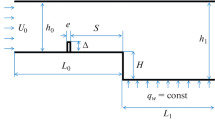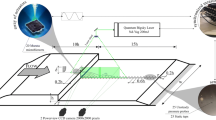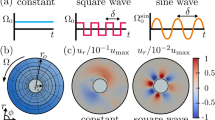Abstract
We study a modified backwards-facing step flow, with the addition of two different plates; one is a baseline, impermeable plate and the second a perforated one. An experimental investigation is carried out for a turbulent reattaching shear layer downstream of the two plates. The proposed setup is a model configuration to study how the plate characteristics affect the separated shear layer and how turbulent kinetic energies and large-scale coherent structures are modified. Measurements show that the perforated plate changes the mean flow field, mostly by reducing the intensity of reverse flow close to the bottom wall. Disturbance amplitudes are significantly reduced up to five step heights downstream of the trailing edge of the plate, more specifically in the recirculation region. A loudspeaker is then used to introduce phase-locked, low-amplitude perturbations upstream of the plates, and phase-averaged measurements allow a quantitative study of large-scale structures in the shear-layer. The evolution of such coherent structures is evaluated in light of linear stability theory, comparing the eigenfunction of the Kelvin–Helmholtz mode to the experimental results. We observe a close match of linear-stability eigenfunctions with phase-averaged amplitudes for the two tested Strouhal numbers. The perforated plate is found to reduce the amplitude of the Kelvin–Helmholtz coherent structures in comparison to the baseline, impermeable plate, a behavior consistent with the predicted amplification trends from linear stability.















Similar content being viewed by others
References
Adams EW, Johnston JP (1988) Effects of the separating shear layer on the reattachment flow structure Part 1: Pressure and turbulence quantities. Exp Fluids 6:400–408
Adams EW, Johnston JP (1988) Effects of the separating shear layer on the reattachment flow structure Part 2: Reattachment length and wall shear stress. Exp Fluids 6:493–499
Adrian RJ (1991) Particle-imaging techniques for experimental fluid mechanics. Annu Rev Fluid Mech 23(1):261–304
Adrian RJ, Yao CS (1985) Pulsed laser technique application to liquid and gaseous flows and the scattering power of seed materials. Appl Opt 24(1):44–52
Ayton LJ (2016) Acoustic scattering by a finite rigid plate with a poroelastic extension. J Fluid Mech 791:414–438
Beneddine S, Sipp D, Arnault A, Dandois J, Lesshafft L (2016) Conditions for validity of mean flow stability analysis. J Fluid Mech 798:485–504
Bhattacharjee S, Scheelke B, Troutt TR (1986) Modification of vortex interactions in a reattaching separated flow. AIAA J 24(4):623–629
Boujo E, Gallaire F (2015) Sensitivity and open-loop control of stochastic response in a noise amplifier flow: the backward-facing step. J Fluid Mech 762:361–392
de Brederode V, Bradshaw P (1972) Three-dimensional flow in nominally two-dimensional separation bubbles: flow behind a rearward-facing step I. Department of Aeronautics, Imperial College of Science and Technology, London
Bridges TJ, Morris PJ (1984) Differential eigenvalue problems in wich the parameter appears nonlinearly. J Comput Phys 55(3):437–460
Brunn HH, Khan MA, Al-Kayiem HH, Fardad AA (1988) Velocity calibration relationships for hot-wire anemometry. J Phys E Sci Instrum 21(2):225–232
Cantwell BJ (1981) Organized motion in turbulent flow. Annu Rev Fluid Mech 13:457–515
Cavalieri AVG, Wolf WR, Jaworski JW (2016) Numerical solution of acoustic scattering by finite perforated elastic plates. Proc R Soc A 472(2188):20150767
Cavalieri AVG, Agarwal A (2013) The effect of base-flow changes in Kelvin-Helmholtz instability. In: Proceedings of the nineteenth AIAA/CEAS aeroacoustics conference, AIAA, Berlin, GER, vol 2088, pp 1–16
Chun KB, Sung HJ (1996) Control of turbulent separated flow over a backward-facing step by local forcing. Exp Fluids 21(6):417–426
Cohen J, Wygnanski I (1987) The evolution of instabilities in the axisymmetric jet. Part 1. The linear growth of disturbances near the nozzle. J Fluid Mech 176:191–219
Crow SC, Champagne FH (1971) Orderly structure in jet turbulence. J Fluid Mech 48:547–591
Eaton JK, Johnston JP (1981) A review of research on subsonic turbulent flow reattachment. AIAA J 19(9):1093–1100
Fontaine RA, Elliott GD, Austin JM, Freund JB (2015) Very near-nozzle shear-layer turbulence and jet noise. J Fluid Mech 770:27–51
Freymuth P (1966) On transition in a separated laminar boundary layer. J Fluid Mech 25:683–704
Gautier N, Aider JL (2013) Control of the separated flow downstream of a backward-facing step using visual feedback. Proc R Soc A 469(2160):20130404
Ho CM, Huerre P (1984) Perturbed free shear layers. Annu Rev Fluid Mech 16(1):365–422
Host-Madsen A, McCluskey DR (1994) On the accuracy and reliability of PIV measurements. In: Seventh international symposium on the application of laser techniques to fluid mechanics, Lisbon, pp 1–11
Hussain AKMF, Reynolds WC (1970) The mechanics of an organized wave in turbulent shear flow. J Fluid Mech 41(2):241–258
Jaunet V, Jordan P, Cavalieri AVG (2017) Two-point coherence of wave packets in turbulent jets. Phys Rev Fluids 2(2):024604
Jaworski JW, Peake N (2013) Aerodynamic noise from a poroelastic edge with implications for the silent flight of owls. J Fluid Mech 723:456-479
Keane RD, Adrian RJ (1992) Theory of cross-correlation analysis of PIV images. Appl Sci Res 49(3):191–215
Luo H, Fang X, Ertas B (2009) Hilbert transform and its engineering applications. AIAA J 47(4):923–932
Michalke A (1965) On spatially growing disturbances in an inviscid shear layer. J Fluid Mech 23(3):521–544
Moore CJ (1977) The role of shear-layer instability waves in jet exhaust noise. J Fluid Mech 80(2):321–367
Oberleithner K, Rukes L, Soria J (2014) Mean flow stability analysis of oscillating jet experiments. J Fluid Mech 757:1–32
Pralits JO, Hanifi A, Henningson DS (2002) Adjoint-based optimization of steady suction for disturbance control in incompressible flows. J Fluid Mech 467:129-161
Prasad AK, Adrian RJ, Landreth CC, Offutt PW (1992) Effect of resolution on the speed and accuracy of particle image velocimetry interrogation. Exp Fluids 13(2–3):105–116
Rienstra SW, Hirschberg A (2004) An introduction to acoustics. Technische Universiteit Eindhoven, Eindhoven
Roos F, Kegelman J (1986) Control of coherent structures in reattaching laminar and turbulent shear layers. AIAA J 24(12):1956–1963
Sasaki K, Cavalieri AVG, Jordan P, Schmidt O, Colonius T, Brès GA (2017) High-frequency wavepackets in turbulent jets. J Fluid Mech 830
Schmid PJ (2007) Nonmodal stability theory. Annu Rev Fluid Mech 39:129–162
Schmid PJ, Henningson DS (2001) Stability and transition in shear flows. Springer, Berlin
Simpson RL (1989) Turbulent boundary-layer separation. Annu Rev Fluid Mech 21(1):205–232
Sinha SN, Gupta AK, Oberai MM (1981) Laminar separating flow over backsteps and cavities Part I: Backsteps. AIAA J 19(12):1527–1530
Soria J (1996) An investigation of the near wake of a circular cylinder using a video-based digital cross-correlation particle image velocimetry technique. Exp Thermal Fluid Sci 12(2):221–233
Trefethen LN (2000) Spectral methods in MATLAB. SIAM, Philadelphia
Trip R, Fransson JHM (2014) Boundary layer modification by means of wall suction and the effect on the wake behind a rectangular forebody. Phys Fluids 2(12):125105
Trip R, Fransson JHM (2017) Bluff body boundary-layer modification and its effect on the near-wake topology. Phys Fluids 29(9):095105
Wee D, Yi T, Annaswamy A, Ghoniem AF (2004) Self-sustained oscillations and vortex shedding in backward-facing step flows: simulation and linear instability analysis. Phys Fluids 16:3361
Westerweel J (1994) Efficient detection of spurious vectors in particle image velocimetry data. Exp Fluids 16(3–4):236–247
Willert CE, Gharib M (1991) Digital particle image velocimetry. Exp Fluids 10(1):181–193
de Brederode V (2014) Aerodinamica Incompressivel: Fundamentos. IST Press, Lisboa
Acknowledgements
This work was partly supported by CNPq Grant 444796/2014-2 and also by The Boeing Research and Technology–Brazil through the Boeing University Relations Program. The authors gratefully acknowledge the FENG laboratory for the support in the design, manufacturing and operation of the experimental campaign. We also thank Peter Jordan, Ardeshir Hanifi and Dan Henningson for the useful discussions. Pedro C. Ormonde acknowledges the financial support from CAPES via a M.Sc. scholarship. André Cavalieri was supported by a CNPq research scholarship.
Author information
Authors and Affiliations
Corresponding author
Additional information
Publisher's Note
Springer Nature remains neutral with regard to jurisdictional claims in published maps and institutional affiliations.
Appendix
Appendix
1.1 Comparison between classical backwards-facing step (BFS) and impermeable case
In this section we present hot-wire measurements for the mean velocity and rms profiles at \(X=1\) for two configurations: the impermeable plate, presented here as our baseline case, and the classical backwards-facing step. Figures 16 and 17, respectively, show the measured mean velocities and rms profiles using a single hot-wire anemometer, and we can observe that the general aspects of the flow for the impermeable plate closely resembles a classical BFS configuration. Since the measuring instrument does not differentiate forward to reverse flow, the positive velocities depicted in Fig. 16 close to the bottom wall (\(Y<0\)) should not be taken as an exact value; elsewhere, measurements are accurate. The two curves provide evidence that the main aspects of the flow for the impermeable case are similar to that of a classical BFS. Figure 17 presents the rms profiles for the two configurations. We observe that the fluctuations are similar in their measured amplitudes as well as in the overall shape of the curves along the vertical y-direction.
The underlying idea in the adoption of the impermeable plate as our baseline case is the advantage of isolating the effects of the perforations to small disparities that arise from the different boundary conditions between the classical BFS flow and the baseline case chosen for this work. The decision of taking the impermeable plate configuration as our baseline case is, therefore, justified considering that, although not identical, our baseline case is sufficiently similar to the well documented, classical BFS flow configuration.
Absolute value of mean velocity profiles measured by hot-wire anemometry at \(X=1\). Solid line (blue, open circles): impermeable plate. Dotted line (black, cross symbols): classical backwards-facing step. Even though the anemometer cannot differentiate reverse to forward flow, profiles show that both flows (impermeable case and classical BFS) are qualitatively similar
1.2 Signal processing
The conditional sampling procedure is described in more details here, with a brief discussion about the quantities of interest in the eduction of coherent structures for this work.
A hot-wire signal \(f(\mathbf {x},t)\) is acquired simultaneously with the forcing wave g(t). To calculate the phase-averaged signal and extract a meaningful information about the coherent fluctuations of the flow, we first evaluate the spectral content of the excitation g(t). Imperfections of the signal generation inevitably lead to slight changes of the excitation signal if compared to a purely sinusoidal wave, and there is often a slight frequency drift for longer time series. This brings a problem in the conditional sampling, since small oscillations in the phase of our reference signal can spoil the results, given that we are searching to extract a low-amplitude, periodic frequency component from a turbulent, high-amplitude signal \(f(\mathbf {x},t)\).
This problem can be circumvented by applying the Hilbert transform H(g)(t) on the forcing signal (Luo et al. 2009). The Hilbert transform is defined as the convolution of g(t) with the function \(1/\pi t\)
where \({\mathbf {p.v.}}\) is the Cauchy principal value of the improper integral. The Hilbert transform is a linear operator, allowing the real-valued signal g(t) to be extended into the complex plane. If g(t) is a quasi-sinusoidal real-valued signal, its Hilbert transform h(t) is a similar real-valued signal, in quadrature with g(t); therefore, we can construct another function \(z(t)=g(t)+\mathrm {i}h(t)\), and extract the instantaneous phase of the excitation signal as the argument of z(t). Now, the phase-averaged signal \(\langle f(\mathbf {x},t) \rangle\) of the flow field for a finite signal \(f(\mathbf {x},t)\) is calculated as
where \(K = \frac{t_{record}}{\tau }\) is the number of total cycles contained in the recorded signal (\(t_{record}\)) and the phase is divided into N parts, e.g., \(\phi _n = \frac{n 2\pi }{N} = \left[ \frac{1}{N} 2 \pi , \frac{2}{N} 2 \pi , \ldots , 2 \pi \right]\) and is equivalent to Eq. (3) as \(K \rightarrow \infty\) and \(N \rightarrow \infty\).
An example of the wave component \(\tilde{f}(\mathbf {x},t) = \langle f(\mathbf {x}, t) \rangle - \bar{f}(\mathbf {x}, t)\) extracted from the anemometer’s time series \(f(\mathbf {x},t)\) is shown in Fig. 18 in comparison to the turbulent hot-wire signal. The phase-averaged signal is Fourier transformed and the resulting Fourier coefficients \(F_n = A_n + i B_n\) represent each mode, containing information about its amplitude and phase. \(F_0\) is real, and represents the mean value (equal to zero for this case), while \(F_{1}\) is related to the fundamental frequency, i.e., the excitation frequency we are interested in. The fundamental is thus the quantity used in this work to compare the coherent turbulence to predictions of linear stability theory.
Excitation wave, hot-wire and phase-averaged signals from a measurement with external forcing at 112 Hz. Figure not drawn to scale. Solid bottom line (blue): excitation wave g(t). Solid upper line (black): hot-wire noisy signal; dashed line (red): phase averaged signal after processing \(\tilde{f}(t)\)
Rights and permissions
About this article
Cite this article
Ormonde, P.C., Cavalieri, A.V.G., Silva, R.G.A.d. et al. Passive control of coherent structures in a modified backwards-facing step flow. Exp Fluids 59, 88 (2018). https://doi.org/10.1007/s00348-018-2543-y
Received:
Revised:
Accepted:
Published:
DOI: https://doi.org/10.1007/s00348-018-2543-y







